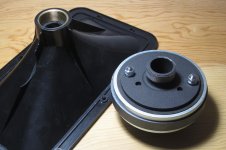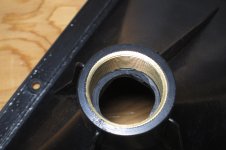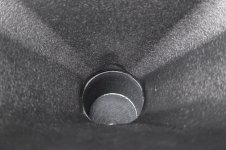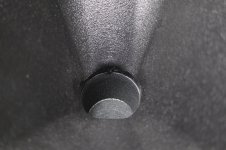I have a pair of flange-mounted Eminence horns and a set of Dayton H6512 waveguides to compare sound for a 2-way speaker. I will mount both in a simple chipboard prototype box and see how they measure and sound to my ears before I advance to the final routed cabinet.
Despite the quality Eminence screw-on adapter EB 2 SA there is naturally a small but pronounced gap between the aluminum adapter and the waveguide's plastic. I made some pictures for you, the gap is only thin, but I think it has to be filled and also the plastic to be smoothed where it protrudes, for which a file can be used. But what do you use to fill/modify the surface of waveguides/horns? Here it should stick to the waveguide I think. Can you name some suggestions which I can buy preferably in Europe or give the technical term for a brand product which may only be available on your continent?
Regards
Despite the quality Eminence screw-on adapter EB 2 SA there is naturally a small but pronounced gap between the aluminum adapter and the waveguide's plastic. I made some pictures for you, the gap is only thin, but I think it has to be filled and also the plastic to be smoothed where it protrudes, for which a file can be used. But what do you use to fill/modify the surface of waveguides/horns? Here it should stick to the waveguide I think. Can you name some suggestions which I can buy preferably in Europe or give the technical term for a brand product which may only be available on your continent?
Regards
Attachments
I was rather thinking of something permanent but also, clay may easily fall off once dried because it has no power to stick to a non porous surface like plastic.
I also asked the my local art material supply for a form of sticky non-hardening material that a user once suggested but they could not come up with it. I think it was modelling clay the sort children use to their fun and the demise of the interior. Someone had experience with this?
I also asked the my local art material supply for a form of sticky non-hardening material that a user once suggested but they could not come up with it. I think it was modelling clay the sort children use to their fun and the demise of the interior. Someone had experience with this?
Last edited:
True, but it would let you see what the change would be without risking anything in the short term.
If the Putty/Clay works then just duplicate it with Epoxy Putty.
If the Putty/Clay works then just duplicate it with Epoxy Putty.
Red clay will work just fine, and you can leave it in there if it works for your needs
Many Italian brand cars use red clay for sound proofing cars from the 50’s up to the 70’s
Many Italian brand cars use red clay for sound proofing cars from the 50’s up to the 70’s
Are automobile body fillers / wood fillers suitable for this purpose ? I have plans to CNC a wooden horn in parts (slices) and have been thinking about using wood waste powdered and mixed with glue.
Sheeple: I suggest using some plumber's teflon tape on that screw.
Sheeple: I suggest using some plumber's teflon tape on that screw.
Last edited:
I would suggest plumbers putty because it stays flexible but it has a bad habit of drawing the plasticizers out of plastic making it brittle with cracking ensuing.
The gray duct seal that i have used on residential and commercial ductwork I've gotten from the hvac suppliers does harden and is very toxic during application.
Maybe try clay mixed with a bit of wood glue so it won't fall apart.
Bondo works great for most speaker apps.
I would rough up the surface w 80 grit for whatever you end up applying.
HTH.
The gray duct seal that i have used on residential and commercial ductwork I've gotten from the hvac suppliers does harden and is very toxic during application.
Maybe try clay mixed with a bit of wood glue so it won't fall apart.
Bondo works great for most speaker apps.
I would rough up the surface w 80 grit for whatever you end up applying.
HTH.
Last edited:
The Gardner Bender 1lb brick of duct seal I use to add mass to woofers (for T/S measurements) is still pliable after 6 years use. It is pretty harmless: https://www.gardnerbender.com/-/media/inriver/DS-130_TCHDAT_SDS.pdf?modified=20210329153443
https://www.lowes.com/pd/Gardner-Bender-16-oz-Duct-Seal/4595233
The Duct Seal 1 lb. Compound Plug is ideal for sealing and protecting gaps, holes and conduit openings against dust, moisture, drafts and noise. This easy-to-handle compound is non-conductive, non-toxic and non-deteriorating and will not harden or form a skin under normal conditions.
https://www.lowes.com/pd/Gardner-Bender-16-oz-Duct-Seal/4595233
Last edited:
- Home
- Loudspeakers
- Multi-Way
- what do you use to fill gaps in waveguides/horns?





